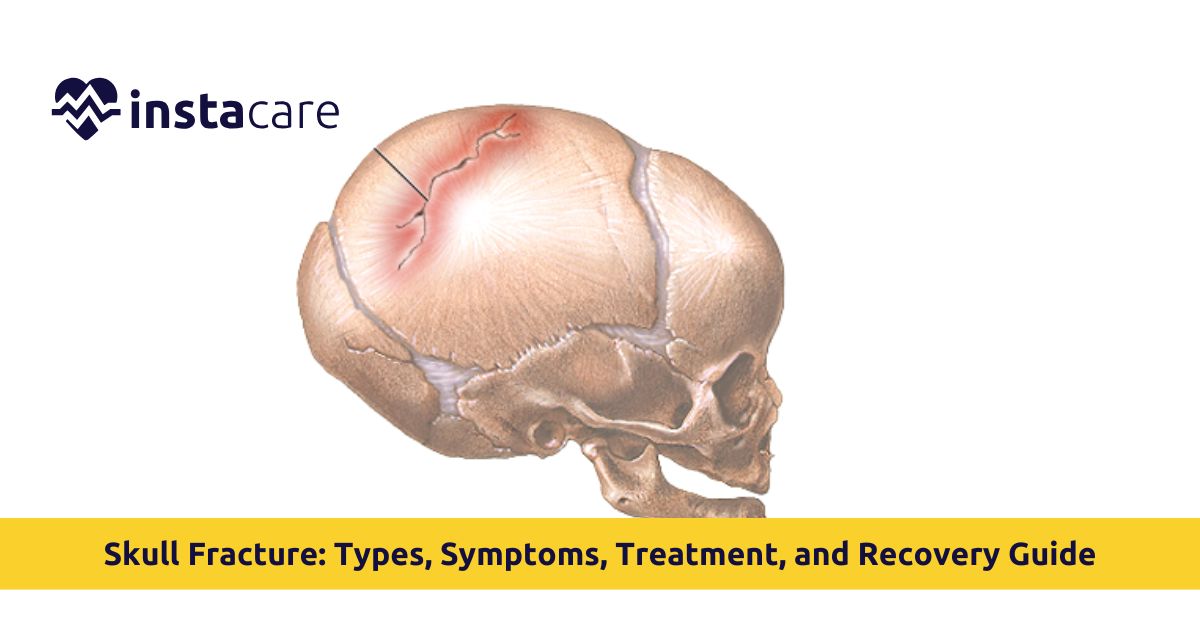Skull fracture is a severe head injury in which the skull bone over the brain cracks or breaks as a result of blunt trauma. From a fall to an accident to a blow, skull fractures range from simple to fatal. Knowledge of skull fracture types, symptoms, and effective treatment is extremely necessary for early and long-term recovery. Everything you need to know about the skull fracture symptoms and diagnosis, causes of skull fracture, treatment, and what occurs during healing of the skull fracture is in this e-book.
What Is a Skull Fracture?
A skull fracture is a break or crack of the cranial bone where the brain is kept and protected. The skull being hard and rigid, a lot of force is required to break the skull. Although very minimal trauma can break the skull, particularly in the elderly and infants.
Skull fractures range from minor to severe and sometimes skull fracture complications like brain injury, bleeding, or infection can arise. The risk is usually not in the fracture but in the occult brain or tissue injury in the majority of cases.
Types of Skull Fractures
Skull fractures are classified based on their appearance, severity, and where they are located. These are the general types of skull fractures:
Linear Skull Fracture
This is the most frequent type. There is a direct, linear fracture of the bone with no displacement here. Linear skull fracture is not operated on unless complicated.
Depressed Skull Fracture
In this type, a piece of the skull is depressed by trauma. It presses on the brain and needs immediate skull fracture treatment. The operation of skull fracture is usually becomes necessary to relieve the depressed bone.
Basilar Skull Fracture
This is a foreboding fracture at the base of the skull and may lead to laceration of brain coverings. It is characterized by blood or clear fluid dripping from the ears or nose. Basilar skull fractures are handled as medical emergencies due to their direct relation with vital structures of the brain.
Diastatic Skull Fracture
Most commonly seen in toddlers and babies, this is a case of sutural widening (where the bones of the skull meet). Treated most commonly with observation, but no surgery is necessary. They all share complications of skull fracture in the way of internal
hemorrhage, infection, or swelling of the brain.
Common Symptoms of a Skull Fracture
Symptoms of skull fracture depend on the extent and site of the fracture. Symptoms can be immediate or delayed.
Some of the common signs of a skull fracture are:
- Headache
- Discomfort or swelling where injury was done
- Bruising behind the ears or above the eyes (Battle's sign)
- Bleeding from the wound, nosebleed, or earbleed
- Leakage of clear fluid (CSF) through the ears or nose
- Loss of consciousness
- Disorientation or amnesia
- Nausea and vomiting
- Seizure
- Visible deformity of the skull
Conversely, infant skull fracture in children can also present with irritability, vomiting, or swelling of soft spot (fontanelle).
Differentiation between skull fracture vs concussion is required. Both of them have possible causes in head injury but concussion is brain injury without any fracture of the skull, whereas fracture is bone injury and will most probably be presented with some complication.
Diagnosis of Skull Fracture
Diagnosis of skull fracture is usually with a combination of physical examination and imaging tests.
Physical Exam
The physician will look for gross trauma, bleeding, loss of fluid, and neurologic response.
Imaging Procedures
- CT Scan (Computed Tomography): The ideal test to diagnose skull fractures and is most often used with any head trauma.
- X-ray: Used in the case of mild or suspected linear skull fracture.
- MRI: Useful in diagnosing injury to the skull or soft tissues, which will not show up on a CT scan.
The condition must be diagnosed early to avoid complications of skull fracture, such as infection, hematoma, or brain swelling.
Treatment of Skull Fracture
Treatment of skull fracture varies according to the nature and severity of the fracture, and the symptoms and risk of complication in the patient.
Rest and Observation
Treatment of uncomplicated linear skull fracture, particularly without any indication of neurological deficit, is pain medication and observation either at home or hospital.
Medication
Medication for headache or pain
- Antibiotics, particularly in basilar skull fracture, to avoid infection
- Anti-seizure medication in the event of a seizure
Surgery of Skull Fracture
Surgery for skull fracture is generally reserved in:
- Depressed skull fracture with intracranial brain tissue
- Open fractures (skeletal break with broken skin) to avoid infection
- Leakage or bleeding that is continuous
- Complicated fractures with brain swelling or injury to the brain
Hospitalization
Severe and significant ones with or without loss of consciousness, and CSF leaks are hospitalized for supportive care and observation. Early and appropriate handling is preferable to prognosis and prevents long-term neurological morbidity.
What Recovery Process of Skull Fracture
Recovery from a skull fracture varies according to skull fracture and brain injury type. The following is what to anticipate during recovery:
Rest and Monitoring
The greatest thing is plenty of rest. Physical and mental functioning should both be limited for the first two weeks.
Follow-Up Scans
They may need CT or MRI scans to be repeated periodically to allow for healing and to ensure there is no swelling or bleeding in the head.
Symptom Control
- Adhere to the medication for headache or swelling as directed
- Manage dizziness, fatigue, or memory problems with medical management
- Follow-up on physical or occupational therapy if mental or motor function is compromised
Re-Injury Avoidance
Re-injury while undergoing the healing process is potentially lethal. Avoid contact sports and risky activities until your doctor has cleared you.
Emotional Support
Working with patients who have a fractured skull who are mood-swinging, depressive, or anxious. Counselling and emotional support help in returning to normal life. Minimum fractures on average heal in 6 to 8 weeks, but bad fractures, especially with concomitant brain injury, may take months or years.
Conclusion
Skull fracture is an emergent illness and requires early diagnosis and treatment. It is a basilar, depressed, or linear skull fracture; it is essential to know the signs and symptoms and when to get help. Treatment from observation to surgery based on fracture severity and complications.
With prompt medical attention and proper rehabilitation, most are fine. But following injury protocols, follow-up appointments, and monitoring for delayed symptoms are all a part of recovery from a skull fracture.
If you or the person in front of you have suffered head trauma, never assume symptoms. Act fast and you'll save your life and prevent long-term damage.
Please book an appointment with the
Best Neurologist in Lahore, Karachi, Islamabad, and all major cities of Pakistan through
InstaCare, or call our helpline at 03171777509 to find a verified doctor for your disease.

